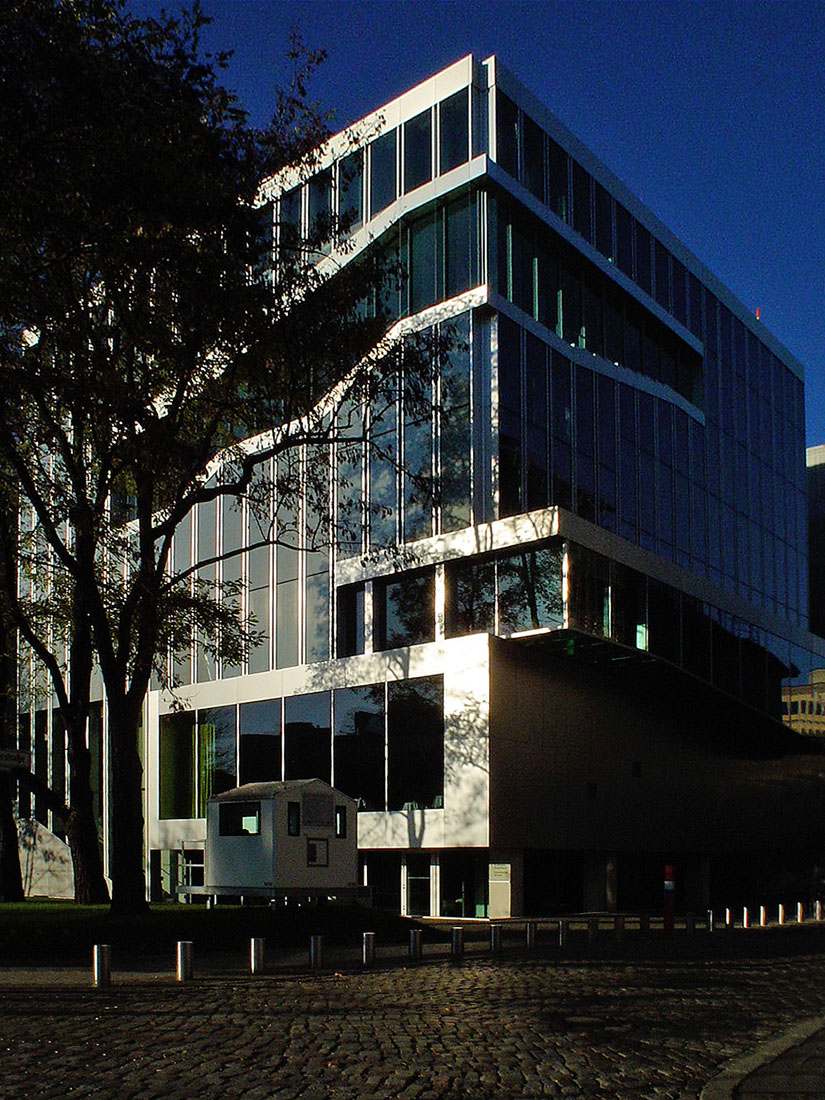 |
 |
 |
 |

OMA - Netherlands
Netherlands Embassy Berlin
Klosterstrasse 50, Berlin
1997 - 2003
From 1921 until the occupation of the
Netherlands in the Second World War, the
Dutch embassy in Berlin was locatd in the embassy district south of
the Tiergarten. The building was located in the immediate vicinity of
the Norwegian Embassy. The Dutch embassy building was destroyed during
the war. Some time later, in 1957, the property was sold. When, after
German reunification, Berlin became the capital again, there was a need
for a new embassy building. The architecture firm Office for
Metropolitan Architecture won the architecture competition, which was
published all over Europe. A solitary building was requested, which
should combine the usual security standards with the Dutch openness.
The building had to meet not only the high expectations by the Dutch
state, but also those by the city of
Berlin. The result is an L-shaped structure which is connected to the
neighboring building. In spite of the surrounding perimeterblocks, the
architects were able to have the cubic
main building freely positioned. The exterior appearance of
the eight-storey building is determined by glass and aluminum. The
heartpiece of the interior is the so-called "trajectory", a circulation
path for the acces of different rooms, twisting up through the entire
building like an apple skin and ending on
the roof. The west façade of the building is marked by a projection,
which is called "Skybox". In this room is the ambassador's dining and
meeting room with a view of the river Spree. The opening ceremony of
the
building took place on 2 March 2004 with the presence of the Dutch
Queen Beatrix and the German Foreign Minister Joschka Fischer. The
building received great international recognition, so it was awarded
the Berlin Architecture Prize in 2003 and received the Mies van der
Rohe Award for European Architecture in 2005.
Die niederländische Botschaft in Berlin befand sich von 1921 bis zur Besetzung der Niederlande im Zweiten Weltkrieg im Botschaftsviertel südlich des Tiergartens. Das Gebäude befand sich in direkter Nachbarschaft zur Norwegischen Gesandtschaft. Der niederländische Botschaftsgebäude wurde im Krieg zerstört. Einige Zeit später, im Jahr 1957 wurde das Grundstück verkauft. Als nach der deutschen Wiedervereinigung Berlin wieder zur Hauptstadt wurde, bestand die Notwendigkeit für ein neues Botschaftsgebäude. Den europaweit ausgeschriebenen Architekturwettbewerb gewann das Architekturbüro Office for Metropolitan Architecture. Gefordert wurde ein solitärer Bau, welcher die gewohnten Sicherheitstandards mit der niederländischen Offenheit verbindet. An das Bauwerk wurden hohe Ansprüche seitens des niederländischen Staates aber auch der Stadt Berlin gestellt. Es entstand ein L-förmiges Bauwerk welches mit der Nachbarbebauung verbunden ist. Trotz umgebender Blockrandbebauung konnte auf diese weise der kubische Hauptbaukörper freigestellt werden. Die äussere Erscheinung des achtgeschossigen Gebäudes wird von Glas und Aluminium bestimmt. Herzstück des Innenraumes ist der sogenannte „Trajekt“, ein Aufgang zur Erschliessung der sich ähnlich einer Apfelschale durch das gesamte Gebäude windet und auf dem Dach endet. An der Westfassade des Gebäudes wurde eine Austragung ausgebildet, welche als „Skybox“ bezeichnet wird. In diesem Raum befindet sich das Speise- und Besprechungszimmer des Botschafters mit Aussicht auf die Spree. Die Eröffnung des Gebäudes erfolgte am 2. März 2004 unter Anwesenheit der niederländischen Königin Beatrix und des deutschen Aussenministers Joschka Fischer. Das Gebäude erhielt grosse internationale Anerkennung, so wurde es 2003 mit dem Architekturpreis Berlin ausgezeichnet und erhielt 2005 den Mies van der Rohe Award for European Architecture.
Die niederländische Botschaft in Berlin befand sich von 1921 bis zur Besetzung der Niederlande im Zweiten Weltkrieg im Botschaftsviertel südlich des Tiergartens. Das Gebäude befand sich in direkter Nachbarschaft zur Norwegischen Gesandtschaft. Der niederländische Botschaftsgebäude wurde im Krieg zerstört. Einige Zeit später, im Jahr 1957 wurde das Grundstück verkauft. Als nach der deutschen Wiedervereinigung Berlin wieder zur Hauptstadt wurde, bestand die Notwendigkeit für ein neues Botschaftsgebäude. Den europaweit ausgeschriebenen Architekturwettbewerb gewann das Architekturbüro Office for Metropolitan Architecture. Gefordert wurde ein solitärer Bau, welcher die gewohnten Sicherheitstandards mit der niederländischen Offenheit verbindet. An das Bauwerk wurden hohe Ansprüche seitens des niederländischen Staates aber auch der Stadt Berlin gestellt. Es entstand ein L-förmiges Bauwerk welches mit der Nachbarbebauung verbunden ist. Trotz umgebender Blockrandbebauung konnte auf diese weise der kubische Hauptbaukörper freigestellt werden. Die äussere Erscheinung des achtgeschossigen Gebäudes wird von Glas und Aluminium bestimmt. Herzstück des Innenraumes ist der sogenannte „Trajekt“, ein Aufgang zur Erschliessung der sich ähnlich einer Apfelschale durch das gesamte Gebäude windet und auf dem Dach endet. An der Westfassade des Gebäudes wurde eine Austragung ausgebildet, welche als „Skybox“ bezeichnet wird. In diesem Raum befindet sich das Speise- und Besprechungszimmer des Botschafters mit Aussicht auf die Spree. Die Eröffnung des Gebäudes erfolgte am 2. März 2004 unter Anwesenheit der niederländischen Königin Beatrix und des deutschen Aussenministers Joschka Fischer. Das Gebäude erhielt grosse internationale Anerkennung, so wurde es 2003 mit dem Architekturpreis Berlin ausgezeichnet und erhielt 2005 den Mies van der Rohe Award for European Architecture.
